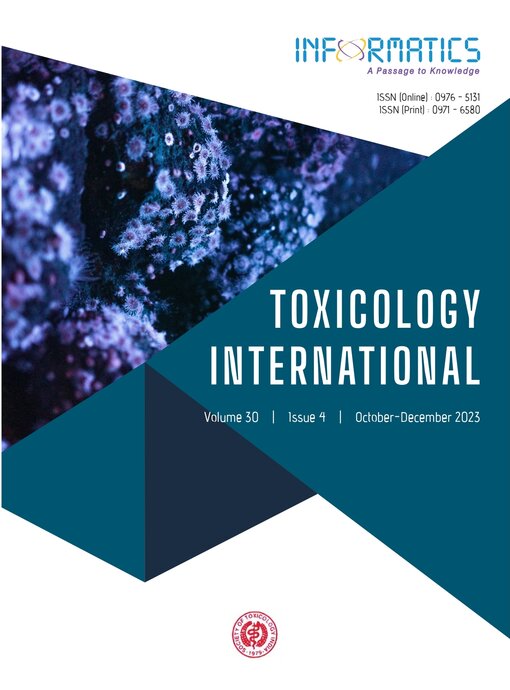Haematological Profile of Various Inbred Strains of Mice Maintained at IMTech Centre for Animal Resources and Experimentation (iCARE)
DOI:
https://doi.org/10.18311/ti/2023/v30i4/35270Keywords:
BALB/c, C57BL/6N, DBA/1, DBA/2, Haematology, MiceAbstract
Animal models are frequently employed in scientific studies to collect data from an entire set of experiments. Haematological tests on these laboratory mice are essential for confirming scientific findings because diverse mouse strains have been used to examine various diseases and novel therapeutic methods. This work is aimed to establish haematological values in mouse strains used in biomedical research. Blood samples were taken from the retro-orbital sinus of mice from various strains and haematological parameters including total White Blood Cells (WBC), Red Blood Cells (RBC), Haemoglobin (HGB), Haematocrit (HCT), Mean Corpuscular Volume (MCV), Mean Corpuscular Haemoglobin (MCH), Mean Corpuscular Haemoglobin Concentration (MCHC), Red Blood Cell Dimension Width ( RDW), platelets, Mean Platelet Volume (MPV) and Platelet Dimension Width (PDW) were assessed. Compared to other strains (BALB/c, M:9.61, F:9.51; C57BL6/N, M:10.13, F:10.73; DBA/2, M:11.96, F:10.88), the mean values of WBCs (*103/μL) in DBA/1 mice were higher (M:14.02; F:14.65) and lower in NOD (M:7.14; F:6.54). The mean RBCs in different strains of mice used in this study ranged from 8.78-11.67*106/μL. Male mean haemoglobin valves in BALB/c, C57BL/6N, DBA/1, DBA/2 and NOD were 14.60, 13.32, 13.00, 14.35 and 13.48 (g/dL), respectively, while in females were 14.3, 14.09, 13.11, 12.65 and 13.24 (g/dL), respectively. The mean platelet counts in NOD mice (M:1826.60 and F:1557.80*103/μL) were significantly higher than other strains. Haematological profiles of the mice used in the study were consistent as reported previously for mice maintained in different animal facilities. The haematological values presented in this study can be used as reference values in biomedical research.
Downloads
Published
How to Cite
Issue
Section
License
Copyright (c) 2023 Sachin Raut, Bhupinder Singh Chopra, Neeraj Khatri

This work is licensed under a Creative Commons Attribution 4.0 International License.
Accepted 2023-11-07
Published 2023-12-11
References
Domínguez Oliva A, Hernández Ávalos I, Martínez Burnes J, Olmos Hernández A, Verduzco Mendoza A, Mota Rojas D. The Importance of Animal Models in Biomedical Research: Current Insights and Applications. Animals. 2023; 13(7): 1-24. https://doi.org/10.3390/ani13071223 PMid:37048478 PMCid:PMC10093480 DOI: https://doi.org/10.3390/ani13071223
Santos EW, De Oliveira DC, Hastreiter A, et al. Valores de Referência Haematológicos e boquímicos para camundongos das linhagens C57BL/6, Swiss Webstere BALB/c. Brazilian Journal of Veterinary Research and Animal Sciences. 2016; 53(2):138-45.https://doi. org/10.11606/issn.1678-4456.v53i2p138-145 DOI: https://doi.org/10.11606/issn.1678-4456.v53i2p138-145
Ferreira LM, Hochman B, Barbosa MVJ. Experimental models in research. Acta Cir Bras. 2005; 20(2):28-34. https://doi.org/10.1590/S0102-86502005000800008 PMid:16283025 DOI: https://doi.org/10.1590/S0102-86502005000800008
Bryant CD. The blessings and curses of C57BL/6 sub strains in mouse genetic studies. Annals of the New York Academy of Sciences. 2011; 1245(1):31-3. https://doi.org/10.1111/j.1749-6632.2011.06325.x PMid:22211972 PMCid: PMC4944652 DOI: https://doi.org/10.1111/j.1749-6632.2011.06325.x
DBA1 Strain Details (000670). Available from: https:// www.jax.org/strain/000670
DBA2 Strain Details (000671). Available from: https:// www.jax.org/strain/000671
Oliveira SMR, Rebocho A, Ahmadpour E, Nissapatorn V, de Lourdes Pereira M. Type 1 Diabetes Mellitus: A review on advances and challenges in creating insulin producing devices. Micromachines. 2023; 14(1):151. https://doi. org/10.3390/mi14010151. PMid:36677212 PMCid: PMC9867263 DOI: https://doi.org/10.3390/mi14010151
Pessini PG, Dos S, de Souza PRK, dos SCC, et al. Haematological reference values and animal welfare parameters of BALB/C-FMABC (Mus musculus) inoculated with Ehrlich tumour kept in the vivarium at ABC Medical School. Animal Models and Experimental Medicine. 2020; 3(1):32-9. https://doi.org/10.1002/ame2.12099. PMid:32318657 PMCid: PMC7167238 DOI: https://doi.org/10.1002/ame2.12099
Santana GS, Bax JC, Fernandes DCS, et al. Clinical haematological and biochemical parameters in Swiss, BALB/c, C57BL/6 and B6D2F1 Mus musculus. Animal Models and Experimental Med. 2020; 3(4):304-15. https:// doi.org/10.1002/ame2.12139. PMid:33532705 PMCid: PMC7824965 DOI: https://doi.org/10.1002/ame2.12139
O’Connell KE, Mikkola AM, Stepanek AM, et al. Practical murine haematopathology: A comparative review and implications for research. Comparative Med. 2015; 65(2):96-113.
Barbosa de BS, Praxedes ÉA, Lima MA, et al. Haematological and biochemical profile of Balb/c Mice. Acta Scientiae Veterinariae. 2017; 45(1): 5. https://doi.org/10.22456/1679-9216.80473 DOI: https://doi.org/10.22456/1679-9216.80473
Kong DY, Park JH, Lee KW, Park H, Cho JA. Comparative analysis of 3 experimental mouse models for blood haematology and chemistry. Biomedical Science Letters. 2016; 22(3): 75-82. https://doi.org/10.15616/BSL.2016.22.3.75 DOI: https://doi.org/10.15616/BSL.2016.22.3.75
Charles River. BALB/c mouse haematology BALB/c mouse biochemistry North American colonies; 2008. http:// animalab.eu/sites/all/pliki/produkty-dopobrania/balb_c_ Mouse_clinical_pathology_data.pdf
Charles River Lab. C57BL/6 mouse haematology C57BL/6 mouse biochemistry North American Colonies; 2012.
Fukuda T, Asou E, Nogi K, Goto K. Evaluation of mouse red blood cell and platelet counting with an automated haematology analyser. The Journal of Veterinary Medical Science. 2017; 79(10):1707-11. https://doi.org/10.1292/ jvms.17-0387 PMid:28845024 PMCA: PMC5658564 DOI: https://doi.org/10.1292/jvms.17-0387
Jackson Laboratory. Physiological Data Summary - BALB/ cJ. 2018; (000651). (000651):651.
Jackson Laboratory. Physiological Data Summary - C57BL/6J mice. 2007; (000664):2007.
Jackson Laboratory. Physiological Data Summary - DBA/2J (000671). 2007; (000671):2007.
Taconic Biosciences. Haematology, Taconic Biosciences; 2023. Available from: https://www.taconic.com/phenotypicdata/ haematology/
Taconic. NOD Mice. Non-Obese Diabetic Mouse Model. Taconic Biosciences; 2023. Available from: https://www. taconic.com/mouse-model/nod
 Sachin Raut
Sachin Raut







